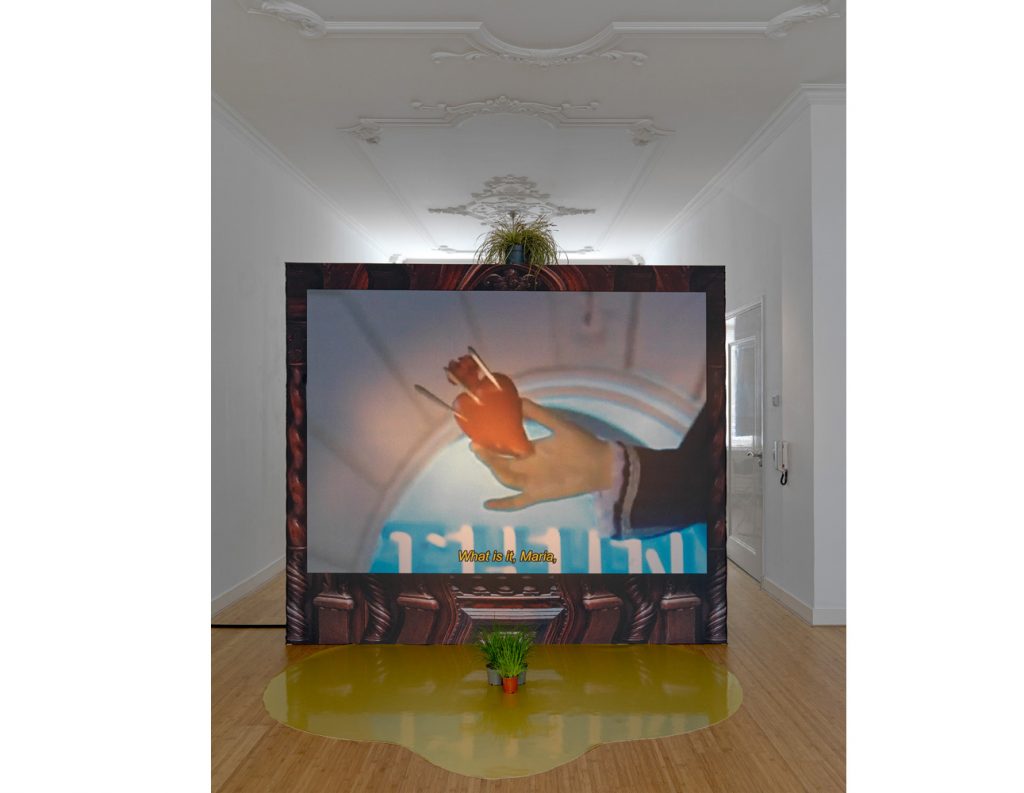Pauline Curnier Jardin: Spectacle, Rituals, and the Body in Excess
At Intersections during Art Rotterdam, Ellen de Bruijne PROJECTS presents Le Lente Passioni (2023) by Pauline Curnier Jardin (b. 1980, France). It’s a theatrical and immersive installation that dissects the spectacle of belief. Part confessional, part campsite, part domestic space, the work explores how Catholic rituals persist, evolve, and adapt - particularly when displaced into digital space.

For over 15 years, Pauline Curnier Jardin has built a practice shaped by theatricality, excess, and transformation, moving fluidly between film, performance, and installation. “It’s always been about what is staged and who is the spectator of that spectacle,” notes Sergi Rusca, gallery curator at Ellen de Bruijne PROJECTS. Born in Southern France and having lived in Italy for many years, her work is infused with the ritualistic intensity of Catholicism, the theatricality of devotion, and the ways in which faith is both deeply personal and inherently performative.
For Le Lente Passioni, Pauline assembled video footage from ethnomusicologists’ archives, capturing Easter processions across Catholic Europe. These rituals were forced onto screens during the first Italian lockdown. Worshippers, unable to gather, adapted: kneeling before televisions, singing alone in their homes, sharing recordings online. These images of faith, fragmented yet enduring, show how devotion is mediated through technology, while still demanding bodily endurance and presence.
Women in Rituals
Curnier Jardin has long been drawn to female archetypes, particularly those at the intersection of power, devotion, and marginalisation: the nun, the virgin, the witch. These figures, deeply embedded in pagan mythology and Christian iconography, have been both revered and feared, often as a means of controlling the female body.
“You see this synchronism of references in her work,” says Rusca. “Pagan elements merge with Christian icons, creating these out-of-this-world characters that sit between the divine and the profane.” Her work revisits these figures, the saint, the martyr, the accused witch, to see how their narratives can be retold, and how they can break out of the roles assigned to them.
This interest in the female body’s suffering and devotion is particularly visible in Fat to Ashes (2019), an earlier work in which Pauline intertwined three ritualistic events: a Catholic festival honouring Saint Agatha, the slaughter of a pig, and Cologne’s Carnival. "Saints are venerated through their pain, Saint Lucia, whose eyes were removed; Saint Agatha, whose breasts were cut off." In Sicily, Agatha is still remembered through the ritual consumption of breast-shaped pastries.
These acts - sacrifice, transformation, and excess - connect bodily endurance, ritualistic repetition, and the boundaries between the sacred and the grotesque. Le Lente Passioni continues this inquiry, shifting the focus from physical rites to their fragmented digital afterlives, where devotion persists even when bodies are absent.

Flesh and Faith
“Christian imagery constantly returns to the aching body, the wounded flesh,” Rusca explains. Catholicism is a faith of the body, where martyrdom and devotion trough pain are integral to its rituals. This is not just theological but theatrical; the blood, the wounds, the endurance of the flesh are spectacles in themselves.
In Le Lente Passioni, these elements manifest in bodies crawling on their knees, rhythmic chanting, and the visceral presence of suffering. “Even in digital form, these rituals still involve endurance, still demand something of the body,” notes Rusca.
The installation itself echoes this tension between intimacy and spectacle. The pierced heart-shaped confessional window disrupts the traditional division between priest and believer, observer and participant. The heart at the centre of the installation reinforces the tripartite and is a direct reference to Christ’s crucifixion.
Triptych Structure: Confessional, Campsite, Domestic Space
Le Lente Passioni’s tripartite structure reflects Christian numerology. “The number three is crucial in Christianity,” says Rusca. "The Holy Trinity, the three days between death and resurrection, even the medieval belief in three nails used to crucify Christ."
In Le Lente Passioni, this sacred structure is reinterpreted. At the front, the installation resembles a campsite, a space where absurdity collides with the weight of the religious imagery inside. Moving inward, a confessional window with a baroque altar print opens onto a television screen, where devotion plays out on-screen. At its core, a glowing TV replaces the altar, reflecting the replacement of physical rituals with digital participation.
Within the film itself, this layering continues. “Inside the video, it’s a TV within a TV,” Rusca notes, referring to believers watching mass online, their faith refracted through screens. The installation asks: what happens when faith is displaced? How does it endure when stripped of its collective, embodied experience?
The wounded heart, a site of devotion and suffering, endures, even as the rituals around it shift.
Written by Emily Van Driessen


